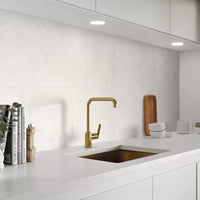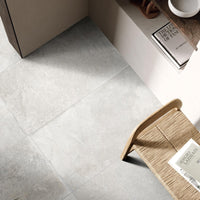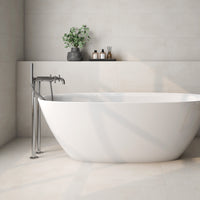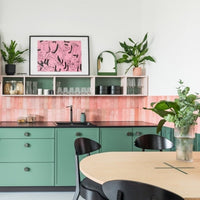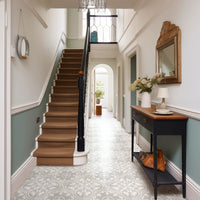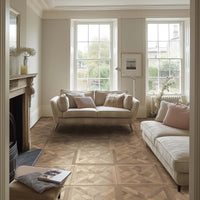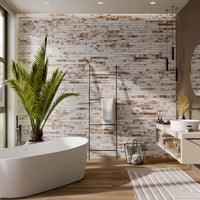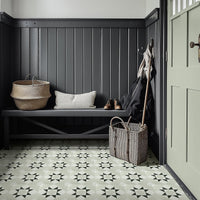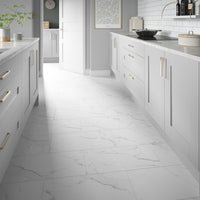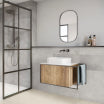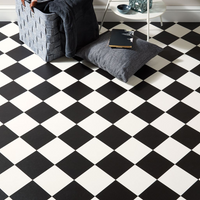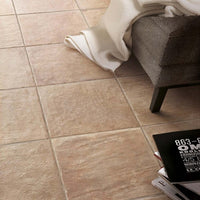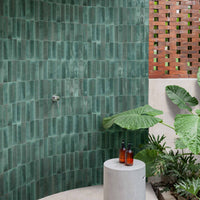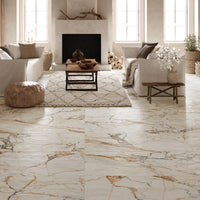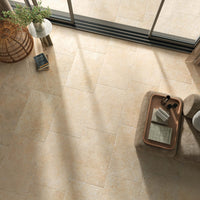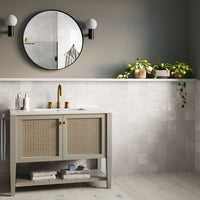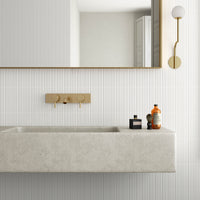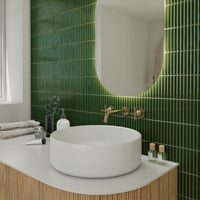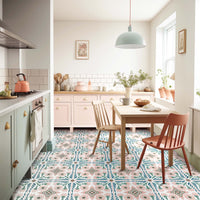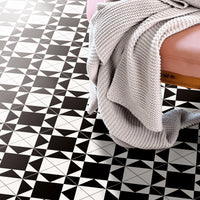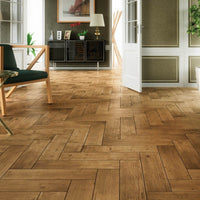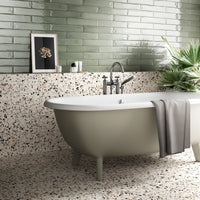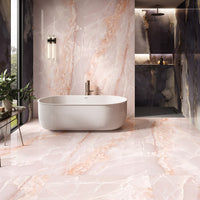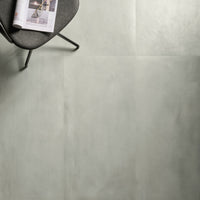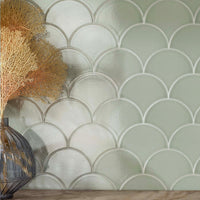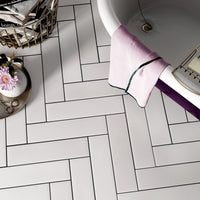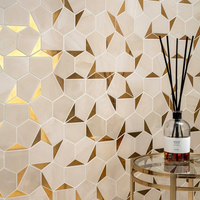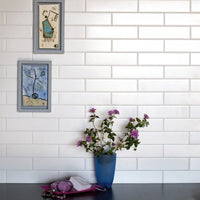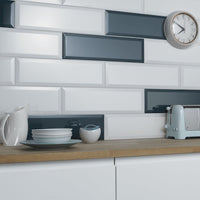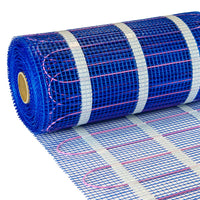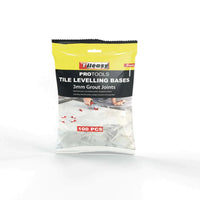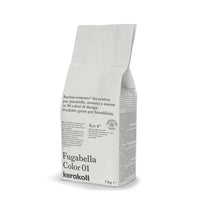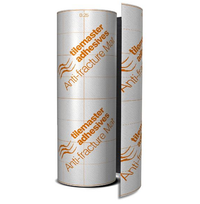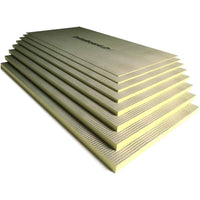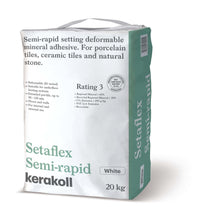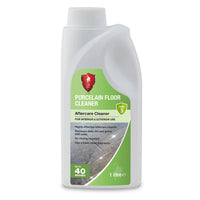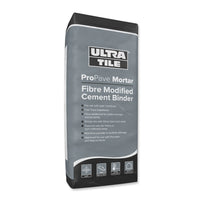Patterned tiles may have been around for centuries but they’re currently one of the design world’s hottest trends. With their playful good looks and splashes of colour, we have to admit we’ve got a rather soft spot for them. And we’re not the only ones. Interior designers and stylists love patterned tiles for their ability to instantly transform a room and you’ll see them popping up everywhere from designer bars to boutique hotels.
As with anything, choosing the right design for your home can be tricky, so we’ve put together this handy guide to help you banish the beige and find your perfect pattern.
What are patterned tiles?
Patterned tiles are exactly what they say on the tin – tiles with lots of colour and decoration! Traditionally, they were made by hand from cement and left to bake in the sun. Whilst beautiful, these tiles are very expensive and need daily TLC to keep their good looks.
On the other hand, today’s patterned tiles are made from ceramic or porcelain using the latest digital printing techniques. This means a whole host of intricate and detail designs are now available, at price points to suit every budget. They’re also incredibly easy to live with and will keep their good looks for years to come.
The wow factor
When it comes to tiles, there’s more choice than ever before and incredibly lifelike imitations of wood, natural stone and marble are currently extremely popular.
However, nothing beats a patterned tile if you’re looking to make your room stand out. It’s a common misconception that the ‘wow factor’ is about being bold and brash, but this isn’t true at all! Whilst plenty of decorative tiles are loud and proud, others are more muted yet still as eye-catching – our Dolce Blue patchwork tiles are the perfect case in point.
We think a great design adds more to your room than just colour – they help define the space and make a style statement. So unleash your inner designer, turn your floors into a feature and let your walls sing out!
What types of patterned tiles are there?
Just a few years ago, patterned tiles were tricky to come by. Thankfully though, times have changed and these days, there’s plenty of different styles to suit any space.
Patchwork
If you love the bohemian and eclectic style, then patchwork tiles are for you. Inspired by traditional Moroccan quilts, they feature a dizzying array of different patterns and prints that are mixed together for a truly eye-catching look.
Many patchwork designs mix different colours together for an individual flavour, but ranges such as Tangier Blue stick to one tone, to give you all the drama in a more muted fashion.
Great for: Porches and hallways, where you want to make a statement.
Victorian
It’s a well known fact that the Victorians loved their decorative tiles, and there’s plenty of choice today if you’d like to share their style. With their geometric patterns and neutral shades, they’re less busy than patchwork tiles so make a great choice if you’re looking for something that doesn’t shout out. Tiles such as Richmond Mosaic are designed to emulate fashion Victorian mosaic patterns. However, they’re actually one single tile rather than lots of small mosaics, so they’re quick to lay and really easy to keep clean.
Great for: Edwardian-style bathrooms with slipper baths and pedestal basins.
Moroccan
If you want to inject a bit of Moorish style into your home, then Moroccan tiles will effortlessly do the job. As you’d probably expect, they’re full of vibrant patterns and sunny colours, the type of tiles you’d expect to find in an old souk or pretty courtyard. To give your room instant character, these tiles have a deliberately aged appearance such as worn glaze or a bumpy surface, to mimic the effect of passing time.
Great for: Splash backs and feature walls
Geometric
Geometric tiles combine a simple, repeating graphic in just two or three colours, so they’re a great choice if you’re looking for a modern style. We love how they give your room a focal point without dominating the space.
Great for: Understated style over larger floor areas
Vintage
Judging by the demand for mid-century and shabby chic furniture, we can’t get enough of retro design. And if you’re looking to give your home an old-meets-new aesthetic, vintage style tiles are a great way to go. Inspired by antique designs, they have a unique style that’s full of character without being too busy. To add to the charm, these tiles are usually designed to look worn and aged, as if they’ve been down for generations.
Great for: Adding character to smaller kitchens and bathrooms
Where can I use patterned tiles?
There’s no right or wrong answer here, you can lay patterned tiles almost anywhere. They can be used to complement or contrast your existing decor, or divide one room from another. If you want to get the most from your new tiles, it pays to consider the style of your space and what you’re looking to achieve. Here’s a few starting points to get your creative juices flowing.
Hallways
An obvious place to use patterned tiles, hallways are usually the first room visitors see so it’s a great idea to go for immediate impact. Look at patchwork style tiles for maximum impact, or choose monochrome floral patterns for something a little less dramatic.
Cloakrooms
Like hallways, cloakrooms are likely to be used by visitors so they’re ideal for making a statement. Don’t be afraid to go a little more ‘out-there’ than you usually would – if there’s one room you can really go for something different, it’s here.
Bathrooms
Bathrooms are a personal space, so think more about your own style than wowing your guests. It’s also important to unwind after a busy day, so look to calmer and more muted patterns to help you relax when you’re having a soak. Victorian floral patterns are always a popular choice as they give your bathroom a fancy touch with a touch of classic English style.
Kitchen Splashbacks
Whether you’ve got a rustic country kitchen or a modern glossy affair, why not look at replacing your current splash back with patterned tiles? You instantly add oodles of character and style, without dominating the rest of the room. And best of all, as splash backs tend to cover a small area it’ll be an inexpensive and easy way to give your kitchen an upgrade.
Feature Walls
A high-impact way to transform your home is to create a dramatic feature wall with a blast of pattern and colour. Decorative tiles are a great way to create a focal point, and will really contrast against a neutral room. Chimney breasts and shower walls are the obvious places to start with, but there’s no reason why you can’t make a feature out of any wall.
Staircases
For something a little unexpected, why not use patterned tiles on your staircase risers? It’s a great idea if you love the look of decorated tiles but don’t have the space for them elsewhere, and it’ll certainly make a talking point! We’d recommend using patchwork tiles for maximum playful impact.
What size is right for me?
Patterned tiles are proof that bigger isn’t always best. They’re usually smaller than your average floor tile, and with good reason – smaller pieces convey the pattern much more dramatically than larger tiles. We’d suggest paying more attention to the style you want to go for rather than the size of the tile.
In general, the smallest patterned tiles are around 15 x 15 cm and the largest around 45 x 45 cm. However, larger tiles usually have ‘pre-cut’ or ‘faux glazed’ grout joints, which give the impression of smaller tiles when laid. So usually, the maximum size for an ‘individual’ tile is 22 x 22 cm.
Installing patterned tiles
One of the great things about today’s patterned tiles is that unlike the cement tiles from days gone by, they’re made from ceramic or porcelain. This means they’re pretty easy to install and can be safely used with any underfloor heating you might have.
Although we would always recommend talking to a professional tiler, if you’d like to have a go at tiling yourself then patterned tiles are a better place to start than the usual floor and wood effect tiles. Their smaller format means they’re easier to work with, especially if you choose a ceramic version.
As mentioned above, some patterned tiles feature a fake or pre-cut grout gap. This speeds up laying the tiles – it’s far easier to lay one tile that’s ‘split’ into four than lay four individual pieces! If your new tile does have a pre-cut joint, make sure to match the size of your actual grout joints to this for a seamless finish.
It’s also worth pointing out that patchwork tiles need a little extra attention when laying. Have a couple of boxes open, dry lay a few square metres and make sure you’re happy with the overall layout. You don’t want to get to the end then realise that two matching tiles are almost side by side!
